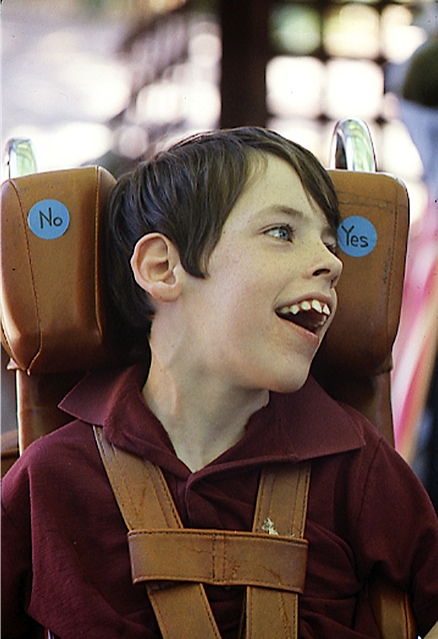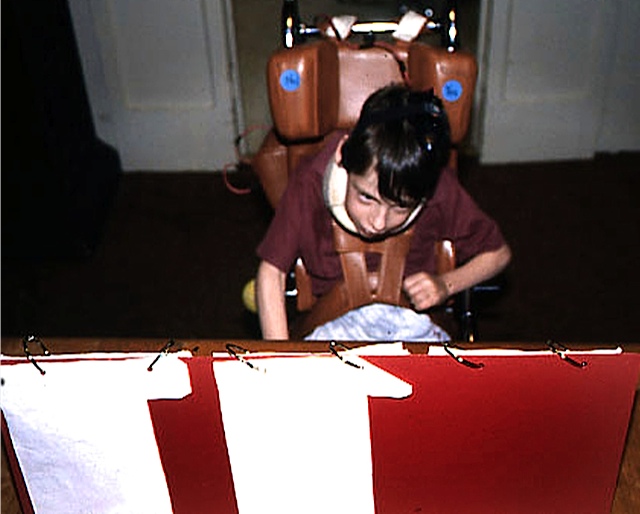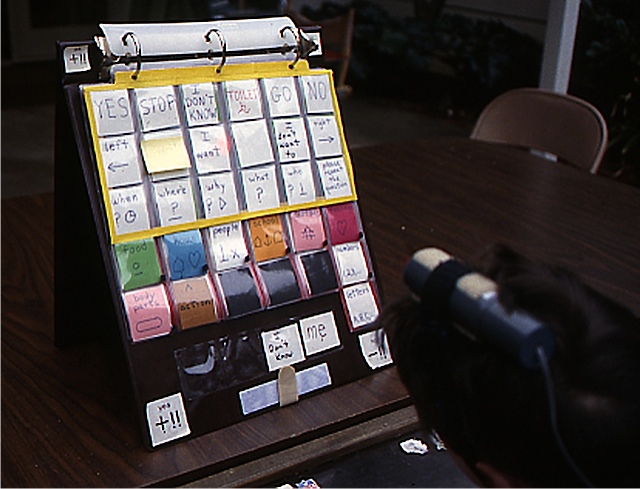Alan was born with cerebral palsy and is nonverbal. He has no functional use of his hands, cannot sit unsupported, or bear weight on his legs. Alan’s communication shines through his laugh, his body language and his eyes.
 You will notice the words yes/no on Alan’s head support. When asked questions that he could answer with ‘yes’ or ‘no’, he would turn his head to the side to indicate his answer. Alan’s ‘yes’ response is on his left and his ‘no’ response to his right. He also has many other ways of saying ‘yes’ or ‘no’ through body language. Some examples are how he’s very good at opening his mouth wide and sticking out his tongue for YES or how he purses his lips, with his head slightly tilted to the right, which means ‘no’.
You will notice the words yes/no on Alan’s head support. When asked questions that he could answer with ‘yes’ or ‘no’, he would turn his head to the side to indicate his answer. Alan’s ‘yes’ response is on his left and his ‘no’ response to his right. He also has many other ways of saying ‘yes’ or ‘no’ through body language. Some examples are how he’s very good at opening his mouth wide and sticking out his tongue for YES or how he purses his lips, with his head slightly tilted to the right, which means ‘no’.
Here Alan uses large icons on flip sheets and a modified bicycle light secured to his head. I made head bands to hold the light in place with soft, non-roll woven elastic. We also tried to use a soft neck brace to give him better control over his head but it really didn’t help much.
This is what the charts look like from Alan’s perspective. Maybe you can see the faint red circle from his light on the picture of juice. This icon chart was quite large and cumbersome to carry around but it allowed Alan to communicate his basic needs and thoughts.
You will also see the word ‘NO’ on his tray on his right (‘YES’ is on the left corner of the tray). With this wheelchair, he did not have the head supports and the yes/no words were placed on his tray where listeners could follow his eye gaze to know his answer.
Here is Alan using a different communication chart. He worked to learn symbols and codes that would be useful for various communication devices. He is using a different light pointer here. This is a laser pointer that had a rechargeable battery pack. It also was stronger than our modified bicycle light and the width of the beam was adjustable.
These communication charts had their drawbacks. First, they were large and needed to be where a table was available to set them on. Alan’s listener had to stand either behind Alan or off to the side to see where his light beam was pointed (there was no sound from these charts) which hindered continuous eye contact between Alan and whoever he was talking with. The initial bicycle light beam was rather dim and it loved to use a lot of batteries.
However, once again, the charts allowed Alan to have more control over his environment, to express his feelings, and make choices of activities he’d like to do.
(There is a lot more to come. Please check back later to follow Alan through his journey of communication development.)





